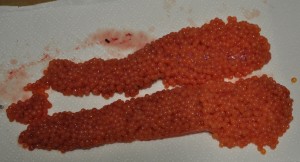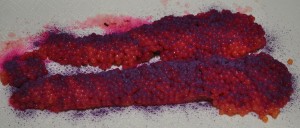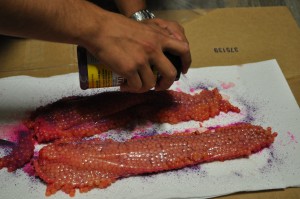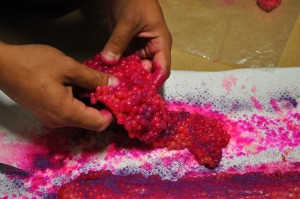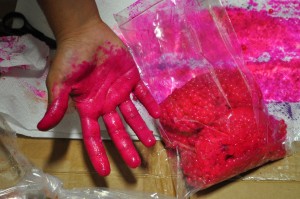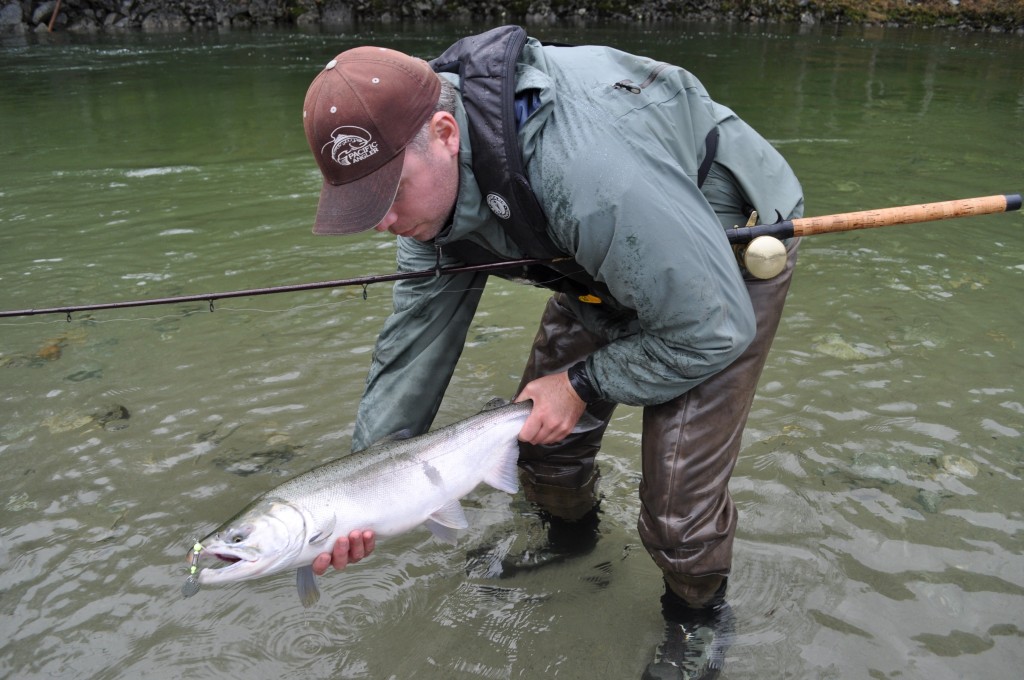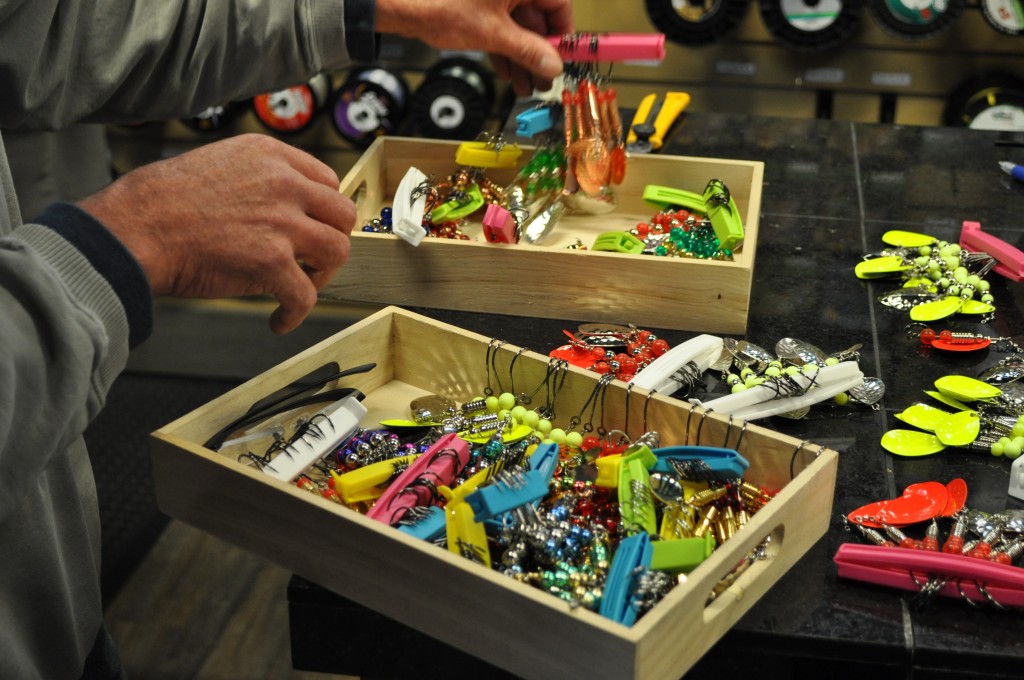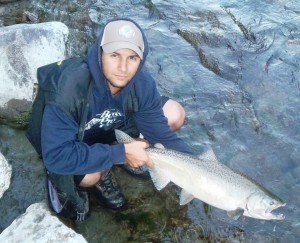Outlook:
Here we go, heading into another long weekend! Happy Thanksgiving to everyone! Keep in mind that Pacific Angler will be CLOSED on the holiday Monday, Oct 14th. Regular hours will be in effect the rest of the weekend.
We are expecting the fishing off of W. Van to be fair to good this weekend with the right flood tides and anchovies down at the bottom.
River heights and clarity are fluctuating at this time and as you will read below, conditions that we were expecting based on research were not being found when we made it to the river. When you are fishing the Squamish you generally want the river height to be between 2.5-3m. When you are researching the Squamish at Brackendale Hydrometric data be sure to refresh the dates for accuracy and use this information as a base for planning. When the water is showing as over 3.5 you are better off checking out other rivers.
We are fully stocked in our fly-tying section so you can come, pick up the materials Andre uses in his coho killers and start tying up for your next day on the water.
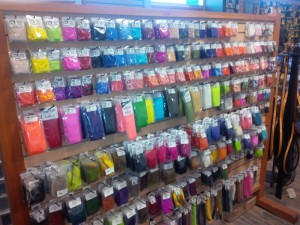
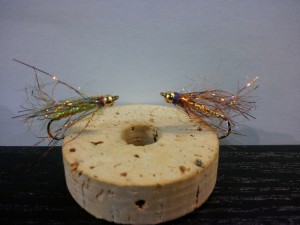
Pacific Angler Educational Tidbits
Dimitri’s “How to Cure Salmon Roe”
Roe Recipe: 1) Butterfly Skeins of roe onto paper towel.
2) Add a light layer of procure or pautzke’s cure to the eggs, covering them evenly.
3) Flip over the skeins onto front and cover the membrane of the skein with cure as well.
4) Massage the cure through out the skeins into all the layers. Make sure to use gloves.
5) Place the roe into a Ziploc bag.
6) Leave the bag in the fridge over night, allowing the eggs to juice out, and then re-accept the juices back inside. *This is the key to having nice eggs is allowing them to soak up all the cure, which in the end gives you big juicy bright roe.
7) After 24hours pull the skeins out of the bag and lay them back onto paper towel to drain.
8) Cut the roe into pieces around the size of a toonie.
9) Take ‘Mule Team’ borax and tumble the roe in it. This dries the roe out as well as toughing up the membrane allowing you to fish it longer.
10) Package the roe in tupperwear containers with fresh borax and freeze. If done properly your roe will look great, fish longer, and last for approx. 6 months!
If you missed our email blast yesterday morning about booking PRIME TIME fall salmon trips with Pacific Angler and our guides, Matt, Ryan and Andre please check out the trip options, prices and descriptions here at Pacific Angler Fall Guided Salmon Trips! Trips are booking extremely quick but prime time spots are still available!
Our Hareline orders and others are in and the walls are fully stocked so you can come and stock up for tying your favorite fall salmon patterns or just buy a couple of Andre’s and then grab the material and tie more up yourself!
Salmon Fishing in Rivers with Spinners, Spoons, and Floats
One of the most important things to consider in pursuit of salmon in rivers is the water conditions. When heading out to your chosen river you will want to consider the following.
Visibility:
Water visibility varies dramatically in direct correlation to weather systems and is very important to the salmon angler. Visibility tells you where you can expect to find fish and what kind of gear you should be using.
In general rivers will follow a predictable routine of rising and becoming dirty with heavy rain fall or snow melt, reaching a maximum height known as cresting, and dropping and clearing to a point where they eventually become low and clear.
The Rise & High Water: Unfortunately when a river starts to rise dramatically the fishing generally slows down or just plain shuts down as fish start to move and adjust to the changing conditions. The good thing is fresh fish will usually move in and the stale fish in the river will move around and eventually become eager biters on the drop. Until then we need to deal with high, dirty water. As the river crests or just starts to drop there can be some great fishing even in the dirty water.
The dirty water provides overhead cover to the fish so they will be very close to shore resting in the slow water. Compounding this factor is that generally the river is high and running very swift and the best resting water for the fish is going to be right on the beach at your feet.
- Brown or milky green water with less than 2 feet of visibility
- Large, bright profile is key and scent or vibration is also an asset
- Procured roe & prawns
- Silver spoons with fluorescent colors
- Bright yarns to hold scent and add profile
- Chartreuse, Flame, Fl. Pink, Fl. Orange
- Think loonie/toonie size presentations
Since you are using large “bait” you need a large hook to maintain a proper hook gap, a heavy leader to hold fish in the fast water, and a short leader to keep your bait in the zone.
- 1/0 to 3/0 hooks
- 12-18 inch leaders
- 15 lb Maxima Ultragreen, no need to go lighter
Concentrate on slow holding water close to shore and work the area very thoroughly by making multiple casts in the zone. Use heavy gear so you can land the fish once hooked. .
The Drop & Green: Once a river starts to drop it will also start to clear. Rivers that are fed by many tributaries will rise and drop fastest while those fed by lakes will rise slower and drop slower. Knowing how fast a river drops is key to timing when it will be in its “green” stage or when there is 3-6 feet of visibility and the water tends to looks an emerald green. This green stage is generally 2-5 days after the rain stops depending on the river and the freezing level.
In this stage there are fresh fish that moved in with the high water and the fish in the river before the high water have also moved upstream or even downstream in major flood events. With increased visibility fish will move from the shore and toward the deeper water on the current seam where they feel more secure. The clearer the water the more they will move to areas with increased overhead security such as surface disturbance or deeper water. These fish are very eager biters. They are starting to settle into good holding lies and respond eagerly to well presented bait. These conditions are when most people have the best success. Unfortunately they don’t last forever as the river will continue to drop and get clear without more precipitation.
- 3-6 feet visibility with a nice green color
- Spoons with silver, gold colours, matched with a fire stripe
- Single rubber eggs in peach, pink, and orange
- Yarn in peach, pink, red and orange shades
- Roe, roe bags, prawns, shrimp, scents
- Colorado blades in silver, gold or brass, size 3
- Think quarter size presentation to nickel size presentation
We can still use some decent size hooks and leader material but we need a longer leader to distance our bait from out weight.
- 2-1/0 hooks
- 18-24 inch leaders
- 8-12lb Maxima Ultragreen leader material
The range of the holding water has expanded so start at the top of the run close to shore and work your way out and cover the entire run right down to the bottom. Fish can be spread throughout the run but the majority of the fish will be found in the tailout. Fish are often caught quickly so don’t spend too much time in one spot. Cover the water properly. Two or three casts in a likely looking spot is enough to tell you if there are fish there. You will catch more fish by covering more runs than pounding one run too long.
Low & Clear: Once we pass through the green stage we enter into a clear water and eventually low and clear water. This is often the most difficult conditions for the average angler. The fish have often been fished on, they are spooky, and tough to catch. People often think all the fish are gone or have pushed through, but they are there and you need to adjust your techniques to catch them. The key is to scale everything down and look in the spots where fish have maximum overhead cover and depth.
- 6 feet plus visibility
- Scale down everything, small float, small weight, small swivel
- Single rubber eggs in natural colors with a touch of peach or white wool
- Small roe bags
- Dime size pieces of roe or shrimp
- Dime size piece of yarn in peach and softer colors, no fl. colors.
- Colorado blades in brass or copper in size 3 or smaller
The fish can get a good look at your gear so we need to use longer leaders, smaller hooks, and thinner leader material. It’s time to use finesse techniques and expect to get fish in behind those who aren’t scaling things down.
With the smaller baits it pays to cover the water thoroughly but you will also get fish on your first time through as well. I tend to fish faster and hope to find eager fish opposed to staying in one spot and hoping one will eventually bite.
- 2-8 hooks, I use 4 (black or bronze) a lot in low clear water
- 24-36 inch leaders
- 6-8lb Maxima Ultragreen leader material
- 8-10lb Fluorocarbon leader material
The information shared can be considered “time-less” to some degree. While new methods can be developed year over year, many of the tested tried and true methods are used every year with continued success!
Stillwaters Report:
Lake fishing is coming to a close in the next 2-4 weeks. That being said, Bryce is heading up to Douglas Lake Ranch and staying at the infamous Stoney Lake Lodge for some well deserved decompression and lake fishing on this long weekend coming up! We will post is success in next weeks report!
If you are hitting up any of the lakes, remember with the frost coming in higher elevations you will be fishing the warmest parts of the day and looking for the season’s last chironomid hatches, scuds, leeches and damsels or dragons on the twitch!
Kane Valley lakes are famous for producing late season chironomid hatches so do not hesitate to escape the river crowds and venture into Kane Valley for some great late season lake fishing!
Whistler lakes
Lake fishing is average in the Whistler area with the temperature dropping pretty quickly. Green lake is quite coloured but still fishable where the creeks empty into the lake. A good place to try is the mouth of Fitzsimmons Creek where it flows through the golf course and empties out into the lake. Successful patterns were black and green leeches. The other lakes in the whistler area were also producing some smaller fish.
River Reports:
Capilano:
There are lots of fish in the Capilano River right now, however enticing them to bite can prove to be difficult at times. Changing things up and going with more neutral colours, along with olive and dark brown can sometimes be the ticket when the heavily pressured fish have been seeing bright spoons and spinners all day. First light and dusk seem to be the best times.
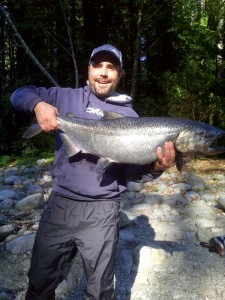
As of yesterday, while fishing the canyon pools fish were reported to be rolling over each other, but they had almost no interest in anything thrown at them. Remember to be careful if fishing the canyon as it is extremely slippery and getting down to the river can prove to be very difficult.
On the way home I took a drive up the Capilano and though it looked high it had good clarity. The graph last night was sitting around 3 and we have heard good reports of guys fishing gear around the mid river catching spring and some big coho. Most are bottom bouncing and some are fishing floats. Though this is a great little fishery we have heard some concerns over snagging and the illegal use of bait. Bait is not legal until the end of the month. So have fun and keep it legal.
Stave River:
The stave is just getting started! Lots of bright chum and a few coho in the system as well. There are hardly any “zombies” swimming around, which is nice! Coho fishing was not as hot as expected, but they are there. Chunky cutthroat trout have been a nice by-catch while stripping flies or retrieving lures for coho. The lack of parking is definitely effecting the number of people on the river, but it is rather frustrating. Smaller and more drab looking coho flies fished on an intermediate sink tip is the ticket in this system. Chum salmon are best targeted float fishing purple jigs or swinging a bright marabou type fly on a light sink tip. Get out there and PLEASE BE RESPECTFUL OF THE FISH.
Max.
Squamish & Mamquam Rivers:
Early week report:
The Squamish and Mamquam rivers were blown out earlier in the week. Sunday saw significant rainfall that continued into Monday causing both rivers to have almost zero visibility. However by Tuesday, the Mamquam was back to running clear with tons of visibility. The Squamish was still quite dirty although people were having some luck throwing spoons for coho. The Mamquam is definitely the river to fish right now as it is full of coho and chum and visibly is great.
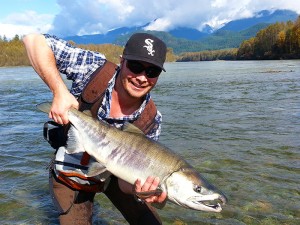
End of week report:
We had a tough day on the Squamish Thursday when I took a client to upper Squamish for a float and we never even put in. We even had to cancel a guided float trip today in order to wait out the conditions. The river was too colored and visibility was very low. This could change in the next 24-48hrs as hopefully the temperatures at night will drop to freezing and allow the river to come into better visibility. River levels are still high but they are dropping and that should change fast.
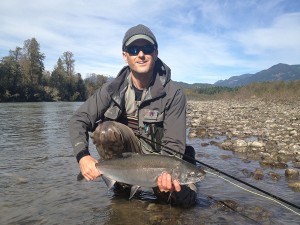
Sea-to-Sky by: Friend of the shop and accomplished angler Jordan Brill lives in the greater Vancouver area and fishes our local systems quite regularly.
This past week saw him fishing our beautiful Sea-to-Sky corridor all the way up to Whistler where he found good fishing for Coho and Chum, as well as the beautifully marked rainbow trout of the Whistler lakes. He found good success using tried and proven techniques as well by changing things up to ‘be a little different’. Sometimes that change CAN be the difference. Quite often we can get ourselves stuck doing what ‘worked last time’ and wondering why we are aren’t connecting. Sometimes in certain areas this works quite well, especially if the fish are being selective and you know what it is that make those specific fish tick- but on those days where we can see the fish rolling at our usual haunts but can’t seem to get them to play, changing things up can
sometimes be the key. In heavily pressured water, fish are often quite used to seeing the same presentation, the same lures, the same colours, and the same baits. By changing things up we are offering the fish something new, and sometimes, that is exactly what they need.
Chilliwack/Vedder: The area has been fishing well for a while now. It is mainly about getting away from the crowds. A customer in the store yesterday confirmed the fishing again as he had great luck higher up the Vedder. Fish are hugging the banks, seams and slower water. Coho, chinook and chum will be there.
Saltwater Report:
The rains have finally dried up and we are once again catching fish only 2 minutes from our dock at the mouth of the Capilano River. Both our boats were out a few days ago and both guides, Ivan & Todd, got their guests into some nice chinook on 6 hour charters off the Capilano mouth. In the past we have had good days at the mouth of the Capilano as late as Oct 24th. In fact we even had a triple header one day this late in the season a few years ago! You can always check out our October archive journal reports from years past to get an idea of the fishing and consistency of certain dates! So take advantage of this fishery while you can and maybe it will be chinook on the dinner table this weekend instead of turkey.
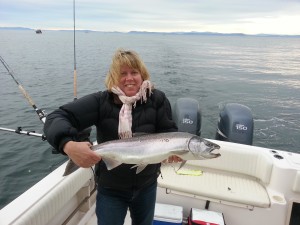
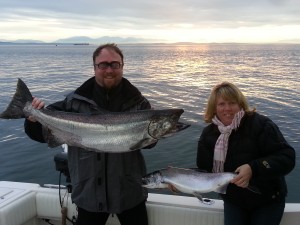
We have also been fishing down at the South Arm of the Fraser and have had some good coho action and even the odd chinook. Both our boats were recently down off the South Arm and we hooked coho, chinook and chum. We are right at peak migration time for coho and we have had some double digit days with a decent mix of wild and hatchery coho. This fishery can provide some great action as we fish 4 rods from depths of 25 to 65 feet and doubles are common and even triple headers when you hit a big school.
To book a charter please feel free to give us a call at 778-788-8582.
For some recent reports and pictures, check out our blog, the “Guide Journal” on our Vancouver Salmon Fishing website!
Pacific Angler Upcoming Courses OCTOBER & NOVEMBER 2013
FLY FISHING FOR SALMON IN RIVERS
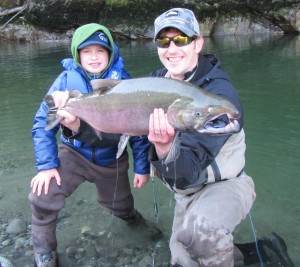
Cost: $225.00 (before taxes)
Date: October 15 (Theory @ Pacific Angler 6:30pm-9:30pm) (ONE SPOT LEFT!!)
On-the-Water: October 19th or 20th (one spot left is on Oct 20th water portion)
Date: Monday, November 4th (Theory @ Pacific Angler 6:30pm-9:30pm)
On-the-Water: November 9th (3spots left) & November 10th (3spots left)
Fly fishing for salmon is one of the most exciting fisheries in the Lower Mainland. Let us teach you the techniques and the hot spots to give you a well rounded foundation. Then put the skills into practice during a fully guided day on the water.
Coho on the fly in the Lower Mainland (SOLD OUT!)
Cost: $225.00+gst
Date(s): October 23 (Theory @ Pacific Angler) 6:30pm – 9:30pm
On-the-Water: October 26th or 27th
Fly fishing for coho in rivers is one of the most challenging yet rewarding fisheries in the Lower Mainland. Your instructor will teach you the techniques and strategies used to fish effectively for these acrobatic fish. You will then put theory into practice during a day on the water featuring demonstrations and person-to-person instruction.
INTRODUCTION TO FLY FISHING

October 16th course is SOLD OUT!
Cost: $100.00 (before taxes)
Date: Wednesday, Nov 13th (Theory at Pacific Angler 630pm – 930pm)
Casting Session: Sunday, Nov 17th 10am – 1pm (location TBD)
INTRODUCTION TO FLY TYING

Cost: $60.00 (before taxes) (2 Spots LEFT!)
Date: Tuesday(s) November 5th, 12th and 19th
Pacific Angler is proud to be your source for fishing education. Call Pacific Angler today, 604-872-2204, to book your spot. All classes have limited availability.
On behalf of the Pacific Angler staff we wish you the best in your fishing endeavors and we hope to see you either at the shop or on the water. To check out the latest Pacific Angler news view the Pacific Angler Facebook page.
Jason, Matt, Andre, Max, Eddie, Jordan and Bryce

